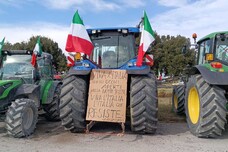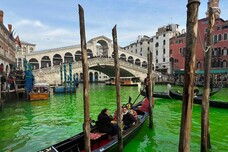(by Silvia Lambertucci)
To see them like this, the blood seeming to still pulse in the
veins of those hands resting on their chests, their curled
fingers, the cotton of the tunic rumpled up on the belly, it
almost seems as if no time at all has passed. They are the
almost complete and unblemished bodies of two men, a 40-year-old
wearing a warm woolen cloak and his young slave already bent by
life's labours; these are the thrilling new revelations of
Pompeii, the fruit of an excavation that went ahead even in
these hardest weeks of the pandemic and which ANSA has been able
to exclusively document. "A truly exceptional find," enthuses
director Massimo Osanna, since September 2020 head of the
general management of public museums," because "for the first
time in over 150 years, ever since the first use of the
technique, it has been possible not only to make perfectly
matching casts of the victims, but also to investigate and
document with new technologies
the things they had with them at the moment they were engulfed
and killed by the eruption's boiling vapours."
It is a riddle that is still partially unsolved, the
archaeologist explains, because it will probably take the next
few months of digs to tell us where the two men were headed and,
who knows, also perhaps to better clarify what their roles were
in the grand and beautifully appointed residence where they were
found.
The site of the new discovery is the suburban villa at Civita
Giuliana, the plush estate of the Augustan era with grand rooms
and terraces giving splendid sea views in whose stables, in
2017, the Park's archaeologists found the remains of three
thoroughbred horses, one even kitted out with a refined saddle
made of wood and bronze and shining tacks, as if it had been got
ready for the imminent departure of its master, in all
probability, Osanna says, "a military commander or a
high-ranking magistrate", perhaps a member of the Mummii, a
storied Roman family of the imperial epoch, given that the same
villa yielded the remains of a frescoed wall with the graffitoed
name of a young girl, the little "Mummia". Whatever the truth
of that, refined and lordly rather like the celebrated Villa of
the Mysteries or like the Villa of Diomedes which inspired so
much literature of the past centuries from Théophile Gautier to
Sigmund Freud, the Villa of the Harnessed Sorrel was able to
boast a breathtaking position, immediately outside the city
walls, with lush terraces and sloping gardens from which the
residents and guests could enjoy the enchanting view of the Bay
of Naples and Capri. Arranged in dozens of different living
areas as was the custom in the richest dwellings, it was
endowed, alongside the ceremonial areas and the noble bedrooms,
"also with an efficient service quarters, with the kitchen
garden, the oil and wine warehouses and ample plots of densely
cultivated land"
The first digs here date back to 1907-1908, by Marquis Giovanni
Imperiali, then owner of the land.
But after digging, the marquis had his men re-inter those areas
without leaving an adequate documentation. The current digs,
entirely funded by the Pompeii Park to the tune of one million
euros, are the product of a joint operation with the
prosecutor's office in Torre Annunziata, prosecutor Pierpaolo
Filippelli, and the Carabinieri, to stop the local tomb raiders,
who have left ample traces of their painstaking activities here.
After the investigation of the stables, since January 2020 there
have been excavations under the very long cryptoporticus, built
under one of the large terraces. ."We were lucky," says Osanna,
"because the area where we found the bodies of the two men had
eluded both the excavations at the start of the 20th century and
the tomb raiders: a trench dug by the tomb raiders passed
virtually beside the feet of one of the two victims". An almost
intact area, and for that reason particularly precious. The last
few weeks have seen archaeologists working at a fever pitch. "We
detected the presence of pockets in the layer of pyroclastic
material and then got the surprise of human remains," says an
enthusiastic Osanna.
Conditions were optimal to try to get casts of the victims,
following the technique perfected in 1863 by Giuseppe Fiorelli.
The last attempt was made in the 1990s, sadly without any great
success. But this time the experiment succeeded perfectly. "It
also worked for what the pair were carrying, which proved to be
a piece of woolen fabric, perhaps another cloak, perhaps a
blanket".
And preliminary studies seem to have already identified the
moment of the end, on the second day of the eruption, the
morning of October 25 (according to a recent new proposed
dating), of that fateful 79 AD. There remains the riddle of the
men's identity. The director shakes his head and shrugs, citing
the precedent of the Villa of Diomedes, where the fist digs, at
the end of the 18th century, restored precisely in the
cryptoporticus the remains of many people, men, women and
children, who had probably felt shielded from the cataclysm in
those underground chambers. Who knows, perhaps the man with the
cloak and the slave who was with him were trying to reach the
rest of the family after having guarded the property from the
outside up to the last moment. The mystery is still open for
now. Osanna, who in a few months will pass the baton to the next
director, urges patience: "Now it is fundamental to continue
the excavations," he concludes. "It will take time, but in the
end the Villa of the Harnessed Sorrel, just like the Villa di
Diomedes where work will conclude in the spring, will be able to
open to the public with all its fascinating stories". And at a
time of a pandemic, he smiles, "the continuation of the
restorations, excavations and studies is also a light
illuminating the future".
ALL RIGHTS RESERVED © Copyright ANSA











